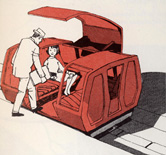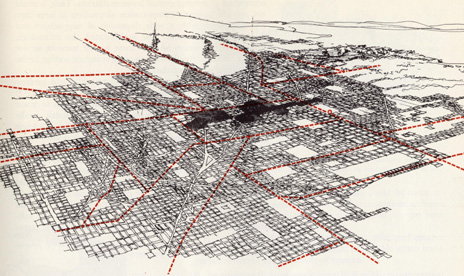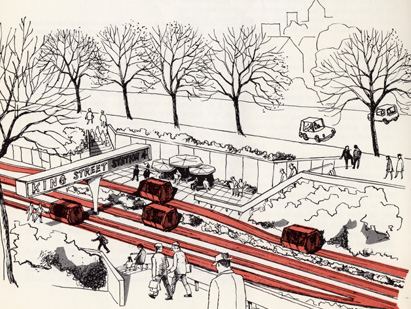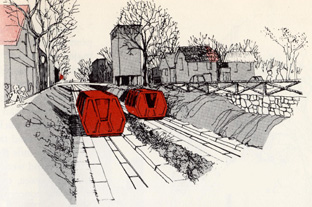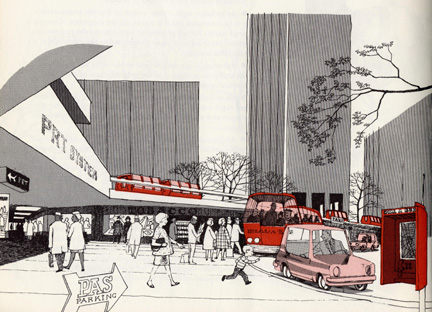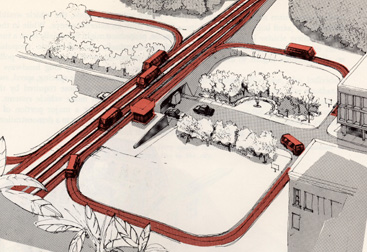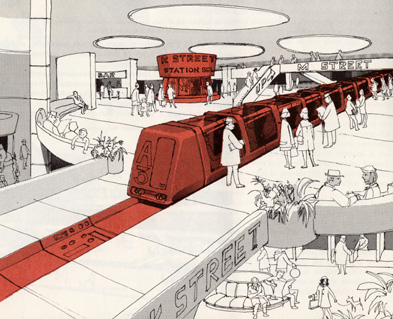The following document is an excerpt from a 100 page report to the U.S. Congress that was submitted in 1968 by President Lyndon Johnson. It was undertaken by the Secretary of the Department of Housing and Urban Development (Robert Weaver) at the request of Congress. Its purpose was to explore areas of research and develop- ment that might ease the problems of Americans who live in and commute to work in cities. Research and develop- ment projects that offer promising prospects for transporta- tion improvements in our cities are identified as is a longer term program of R&D activities, concentrated in areas of greatest promise and benefits. The report contains four sections: Urbanization and Urban Transportation, The Federal Role and Responsibility, What Should Be Done and A Recommended Research and Development Program. The excerpt below comes from the third section and bears the subtitle New Systems for the Future. It is a copy of pages 58-77 from the report.From a 2009 viewpoint, it is a remarkably prescient piece of work. There are few ideas, issues and technologies that are current today that were not identified some 41 years ago. A copy of the full report may be available in large university libraries, such as the U of California at Berkeley and Northwestern University.
RECOMMENDED FUTURE SYSTEMS The following seven major types of new systems of all the many candidates investigated, were found to possess not only a high expectation of technical and economic feasibility but also to contribute significantly to the solution of major urban problems. 1. DIAL-A-BUS (DEMAND-ACTIVATED BUS SYSTEM A major failing of public urban transportation today is its inability to provide adequate and attractive collection and distribution services in lower density areas of a metropolis. In some parts of urban areas and in many small cities and towns, the travel demand is too small to support any transit service at all. It is simply economically infeasible to route and schedule present transit vehicles efficiently when only a few people want to go to and from the same places during a short period of time. Rail systems are too expensive and are technologically unsuited for low volumes of demand. Ordinary buses cannot maintain sufficiently frequent service in outlying areas to attract any but those who have no alternative. What is needed is a public transit system which can respond dynamically to the needs of these areas, that is, a system whose routes and schedules are both flexible and ubiquitous.The Dial-a-Bus, which is a hybrid between an ordinary bus and a taxi, could be the basis for such flexibility. It would pick up passengers at their doors or at a nearby bus stop shortly after they have telephoned for service. The computer would know the location of its vehicles, how many passengers were on them, and where they were heading. It would select the right vehicle and dispatch it to the caller according to some optimal routing program which had been devised for the system. Thus, the system could readily link many origins to many destinations.
A Dial-a-Bus, with it's position established by automatic vehicle monitoring, can be routed by computer and a communication link to collect passengers who have called for service. The diffused pattern of trip origins and destinations which this system would serve is most dominant in low density suburbs. But it also exists in a different form in the most thickly populated urban areas.The cost of taxi rides can be driven down by sharing rides, and basically the Dial-a-Bus system is designed to accomplish this. Data from the new systems study suggest that, depending on demand, door-to-door transit can serve its passengers almost as fast as a private taxi but at one-quarter to one-half the price, indeed, at only slightly more than the fare for a conventional bus.
With its operational flexibility, the Dial-a-Bus system could be programmed to give different levels of service for different fares. At one extreme it might offer unscheduled single pas- senger door-to-door service, like a taxi, or multi-passenger serv- ice, like a jitney. At the other extreme it might operate like a bus service, picking up passengers along specified routes which could include several home pick-ups. The system might also be programmed to rendezvous with an express or line-haul carrier, and in serving as either a collector or distributor, provide the opportunity to improve the complete transportation service. The major point is that the Dial-a-Bus might do what no other transit system now does: Handle door-to-door travel demand at the time of the demand. This means that the system would attract more off-peak business than does conventional transit. And if it does attract enough passengers, the off-peak revenue would help Dial-a-Bus avoid the same financial prob- lems of conventional transit, which is used heavily only 3 or 4 hours per day. It could also help reduce dependence upon automobiles. Technically, there is little question that the system will work. Any number of existing vehicles can comfortably carry 12 to 24 passengers. Some of the best are now offering service to airports. Present computers, radio communications, and telephone links are fully adequate to the major needs of Dial-a-Bus. Mathematical routing and the associated computer programming present no real obstacles. What must be done is to put these isolated elements together into a unified system. Dial-a-Bus service could be made somewhat more efficient if the buses were equipped with automatic monitors to report each vehicle's location, to the dispatchers at frequent intervals. Although these monitors do not now exist, there is no technological barrier to developing them, as discussed above under the automatic ve- hicle monitoring subsystem. The cost for a given level of Dial-a-Bus service is a function of many variables. These include the nature of the street system, the cruising speed of the vehicle, the distribution of demand, and the size of the area served. Perhaps the most uncertain of these variables is demand density, the number of trips generated per square mile per hour. Dial-a-Bus systems probably will be most efficient at demand densities of 100 trips per square mile per hour—a level that is barely practicable for conventional bus service.A limited demonstration of the Dial-a-Bus concept, using
existing equipment, could almost certainly be achieved within
3 years at a cost of less than $1 million. A definitive full-scale
demonstration of Dial-a-Bus service, using vehicles and control
equipment specifically designed for this purpose to test the full
range of possible benefits, probably could be completed within
7 years at a cost of less than $20 million.Current example: http://www.ruf.dk/maxi/index.htm
2. PERSONAL RAPID TRANSIT
The demand for transportation in areas of medium to low
population density is at the present time predominantly served
by private automobiles. Public transit trunklines may traverse
these areas, but collector-distributor service is poor if it exists
at all. More than half the automobile travel in large cities occurs
in such areas in trips longer than 2.5 miles. Increasing travel
demands of this kind, unmet by public transportation services,
tend to encourage multiple-automobile ownership and use;
often these additional automobiles can be neither afforded nor
efficiently accommodated.
To provide accessibility and service to the profusion of origins
and destinations in these metropolitan areas, a system is needed
which can be designed to be more responsive to the requirements
varying population densities and land use patterns might generate.
One such concept is "personal rapid transit," sometimes called
areawide individual transit or network transit. It would consist of
small vehicles, each carrying about the same number of persons
as an automobile. These vehicles would travel over an exclusive
right-of-way or guideway network, either over standard routes,
or else automatically routed individually from origin to destination
at network stations.Personal rapid transit would serve all but the lowest density
suburbs with a network like that shown below. No part of
the urban area would be more than 2 miles from one of the
PRT routes.
Personal rapid transit would provide travelers the important
advantages of minimum waiting time at the origin station,
and private, secure accommodations. At the heart of the con-
cept is the premise that personal transit would serve a metro-
polis, except perhaps for its lowest density outskirts, with a
network or grid of lines, each perhaps a mile or two apart.
Empty passenger vehicles or "capsules" would be available
at each station on the network. The riders would enter one,
select and register their destination, and then be transported
there automatically, with no stopping. The average speed would
be essentially equal to the vehicle speed. The station spacing
on a guideway network for the system would have no influence
on speed of travel. Passenger demand and station costs would
dictate proper station spacing.
Empty vehicles would be recirculated automatically to main-
tain an inventory at each station, and passengers could be
routed past stations without stopping until they reached their
destinations. Ideally, such a system would give travelers the
same privacy as a private automobile, although during peak
periods in cities with particularly heavy corridor movements a
traveler might have to share a vehicle with two or three other
passengers.Shown below is an illustration of an at grade PRT station
which has off-line platforms for picking up and discharging
passengers.
The guideway network covering the metropolitan area is
the essential ingredient of the personal rapid transit system.
Without a network of guideways the system could hardly avoid
conventional heavy dependence on work trips and a radial
orientation to existing central business districts. Thus, it could
not provide adequate transportation alternatives in large met-
ropolitan areas with a wide dispersion of trip origins and
destinations. No matter how sophisticated the technology,
transit which operates without some sort of network service
pattern almost certainly will remain a marginal service in the
movement of urban populations.
Network systems of personal rapid transit would perform
economically with travel demand ranging from 1,000 to 10,000
persons an hour in a travel corridor—the medium to lower
density conditions in which mass transit systems today usually
perform inadequately. Yet these corridor travel demand levels
prevail in most metropolitan areas. The network system, more-
over, could have average speeds of 50 to 70 miles an hour,
a substantial improvement over average urban freeway speeds.
The roadbed or guideway for personal rapid transit might
consist of rails or surfaces for air bearings; the vehicles could
use steel or rubber wheels or air pads. Propulsion could be in
the vehicle or in the guideway itself. Each guideway would
be about 5 feet wide and could be a single-lane over sub-
stantial portions of its length. The narrower and lighter structures
should require less land. They also could be more attractive
than many urban freeways. All these options are open
to the design engineer; no particular solution has yet been
shown to be outstanding. An illustration of a depressed
route is shown below. Other options include elevated,
ground level and underground.
A personal rapid transit system having these performance
characteristics is an important element in a viable urban trans-
portation system for a number of reasons:
• An exclusive right-of-way is essential if public transportation
is to be automated and if it is to escape the congestion of general
street traffic. Forced to compete with automobiles on crowded
streets, other forms of mass transportation are inherently at a
speed disadvantage.
• Automation can make transit service more competitive with
the automobile, since it is the only safe and efficient way to
operate a system using numerous small vehicles.
• Small, individualized vehicles avoid the chief delays of pres-
ent rapid transit: Stops at intermediate stations for other pass-
engers and waiting or dependence on a schedule at the origin
station.
• Additionally, use of small lightweight vehicles, with the quiet
suspension and propulsion mechanisms which can be developed,
and the less massive elevated and station structures such systems
would permit, would minimize the impact of the system on the
environment.
The new systems study found over 20 existing proposals for
various kinds of personalized transit, most of them little ad-
vanced beyond the original concept. The greatest amount of
development work is needed for automatic electronic controls.
Maintaining safe headways to permit stopping in case of an
emergency on the line ahead is a very substantial problem in a
system using small vehicles and yet still aiming at high traffic
volumes. Such operation requires vehicles to be run far closer
together than they can now, but the problems involved in real-
izing this potential require further research.A network of exclusive right-of-way transit on any such scale poses obvious problems other than technical ones. Clearly a major investment would be required, though costs might be reduced by running the guideways on elevated structures using the medians or margins of existing rights-of-way. Tunneled guideways and grade level or depressed guideways would be less expensive than conventional systems requirements because of the smaller vehicle size of personal rapid transit. Personal rapid transit could probably operate at costs below 10 cents per mile if its capacity were 6,000 riders per hour and if the demand were sufficient to generate 15,000 riders per day, on the average, over each section of guideway. In sum, the real issues concerning the feasibility of personal rapid transit systems, as for all new systems, are not merely technological ones, they include the questions of cost and safety as well. These questions cannot be answered with absolute precision at this time, but indications are that personal rapid transit will be many times safer than the private automobile, and yet will cost no more than modern mass transit systems proposed in areas of low to medium volume travel demands.As shown below, personal rapid transit stations in the suburbs could be reached by Dial-a-Bus and by private or public automobile service (PAS).A prototype of such a system could be developed, working perhaps from an existing system such as the Transit Express- way demonstrated in a Housing and Urban Development (HUD) project in Pittsburgh. Such a prototype system might minimize control difficulties, for instance, by requiring passengers to transfer—a requirement that might not be too onerous in some metropolitan areas because networks requiring few transfers could be designed.An illustration of an inner-city personal rapid stations is shown below.The ultimate goal should be a system that does not require this kind of temporizing. Yet control problems become even more complex in the areas of merging one vehicle stream into another and of routing numerous small vehicles automatically over a network of guideways, with provisions for switching off the line at stations, of maintaining adequate supplies of empty cars at stations, and of distributing vehicles so that congestion does not result on any line. The new systems study found that these problems are surmountable, and that a prototype system could be developed, tested, and evaluated in less than 10 years at a cost of about $250 million.
Current examples: http://www.ultraprt.com and http://www.vectusprt.com 3. DUALMODE VEHICLE SYSTEMSOn the outer fringes of the personal rapid transit system just described, the network of lines in the lower density areas, to remain economical, would probably be too far apart for con- venient walking access, and unsuitable for short neighborhood or local trips. The new systems study found the dualmode vehicle system to offer a possible solution to these problems. In a dualmode system, the vehicle can convert easily from travel on a street to travel on an automated network. It thus could serve as a logical extension or elaboration of personal rapid transit.The dualmode vehicles could operate on the parts of the network of lines used by personal rapid transit. Vehicles would drive from the streets onto the guideway at selected PRT stations. Shown below is a small car entering the network through an inspection point, a destination encoder and an automated fare collector.Dualmode personal vehicle systems would give the same service for persons who did not own or know how to drive an automobile as would the personal rapid transit system. They would use public vehicles on the automatic guideways, and would walk or transfer to other systems for local trips. How- ever, the guideways also would be accessible to privately owned or leased vehicles which could be routed on and off ramps con- necting with ordinary streets, and driven over the streets to the driver's destination just as in the case of an automobile. At the point of destination, the vehicles could be parked as they are today or, if they were leased for the trip, they could be turned in at local connection points for redistribution to other users. This last method has the advantage of minimizing parking problems in congested areas. A dualmode system presents more technical development problems than the personal transit system. However, it should be possible to work on such problems simultaneously with the development of personal transit, and to so design personal transit systems for ultimate dual mode use. The earliest developmental problems will be in the adaptation of propulsion, suspension, and guidance systems for use on both automatic guideways and regular streets. None of them seems insurmountable in the light of present knowledge. Propulsion on the guideway, as in the case of the personal transit system, would almost certainly be electric, probably using third rail power distribution in prototypes. In the final develop- ment of the system, however, propulsion might be a version of the linear motor discussed previously. Vehicles would thus need an electric motor; off the guideway they would run on batteries or use a separate engine to generate power for the electric motor. Since these are the directions in which propulsion technology for ordinary automobiles may evolve to achieve reductions in air pollution, the propulsion problems of a dual mode personal vehicle are likely to be solved well before its other problems. The most difficult technical problems are those associated with the development of a control system. Two different courses are possible. One is to concentrate the burden of control in the automated guideway (using equipment like linear synchronous motors and wayside computers) ; the other is to concentrate it in the capsules. The cost and complexity of the guideways would be reduced if the controls were in the capsule, but the controls could be damaged when the capsules were off the guideway and being driven by individuals, and there could be additional safety hazards.
The personal rapid transit system described earlier could operate at less than 10 cents per passenger mile with 15,000 passengers per day; the dual mode system might cost as little as 7 to 8 cents per passenger mile, depending on whether the vehicles were privately or publicly owned. If research and development of personal rapid transit and the dual mode system were undertaken in concert, the prin- cipal costs for guideways, controls, and propulsion systems could be shared. The development, test, and evaluation of street vehicles which could also operate automatically on the guide- ways could add $150 million to the previous $250 million esti- mate. While one first-generation form of the dual mode system could be demonstrated in less than 10 years at a cost of less than $35 million, the full-scale development, test, and evalua- tion of a compatible personal rapid transit and small dual mode vehicle system would be a more uncertain venture and could require a total of about 10 years and $400 million.Current examples: http://www.ruk.dk and Bubbles and Beams video 4. AUTOMATED DUAL MODE BUS Medium-sized industrial cities (200,000 to 400,000 popula- tion) have characteristically had difficulty in supporting public transit service. Population densities are relatively low, and trip distances are short over essentially radial routes between the urban core and outlying residential and industrial areas. Pro- viding peak-hour home-to-work travel, including both that be- tween suburban homes and the rapidly expanding job oppor- tunities in the outlying industrial and commercial zones, poses major transit service problems. Some form of public transit, improved over standard bus service, but with lower initial costs and greater flexibility than rapid rail transit, is desirable to meet the needs of the intermediate-size industrial city.The automated dualmode bus would operate on the public streets as a conventional bus to pick up and discharge passen- gers. On longer high speed runs it would operate as a fully automatic vehicle on a private right-of-way. Thus, it offers the possibility for a system of public transit which combines the high speed capacity of a rail system operating on its private right-of-way with the flexibility and adaptability of a city bus. This flexibility would make it possible for the transit system to serve areas where the cost of extensive fixed rights-of-way could not be justified, and to minimize the number of transfers which the passenger would have to make.
A dualmode bus, after completing an express run on the guideway, would enter the turnout and pick up a driver who would dis- engage the external power supply and continue the run to dis- charge customers or collect others for the next express trip. An illustration of a typical interchange facility is shown below.In the automatic mode, the vehicle would be powered elec- trically from an external source. While in the manual or street mode, propulsion might be initially from a turbo-electric power plant. Eventually, an all-electric propulsion system could achieve minimum levels of noise and air pollution. Because of the relatively long headways between vehicles the controls for intervehicle spacing, speed, switching, and stops are not as complex as those required by the personal rapid transit or small dual mode vehicle systems. Nevertheless, the controls will constitute a major portion of the research and development effort leading to a demonstration of the automated dualmode bus system. Significant efforts will also be required for the design and development of the guideway propulsion system and mainline stops for passenger entry and exit while the vehicles are operated automatically. The redistribution and effective use of vehicles and drivers during off-peak and manual operating periods will require careful analysis. Consideration has been given to the possible use of some of these vehicles as a Dial-a-Bus during off-peak hours. The automated dual mode bus could be developed and its feasibility demonstrated very likely within 5 years at a possible cost of less than $15 million.Current example: http://www.ruf.dk/maxi/index.htm 5. PALLET OR FERRY SYSTEMS The most rapid population and employment growth in Ameri- can cities today is in the suburban areas. As a result, the percentage of trips having an origin or destination in a con- centrated central city area is shrinking, and the number of trips between low density residential areas and decentralized indus- trial and commercial areas is growing. To accommodate this growth pattern and to provide other options of urban development, modes of transportation which span entire metropolitan areas with circumferential, as well as radial links, are essential. A corollary to the dual mode personal vehicle systems which would provide this type of service would use pallets to carry (or ferry) automobiles, minibuses or freight automatically on high-speed guideways.A rail-based pallet or ferry system could make good use of abandoned or seldom used rail line in the city. An illustration of such a concept is shown below,Pallets have several advantages. For one, the individual would not have to buy or lease special vehicles. For another, a single freeway or rail line could be converted to pallet opera- tion; automobiles in the area could use the pallet for high-speed line-haul, thus preserving the quality of automobile comfort without the disadvantages of driving in traffic.
In the rail system, the traveler's private automobile, with the driver and any passengers remaining inside, would be loaded on a pallet and transported at high speed. The automobile would not need special equipment and the pallet vehicle would not need to be much more than a platform or flatcar able to carry about 10 to 12 vehicles. The concept is not limited to rail systems, but could be adapted for guideways with electrically propelled carriers. The system would provide high-flow capacities per lane, as well as automatic operations over long route segments. Load- ing and unloading might be automated, although the operations would have to be restricted to terminals with transfer equipment. A major disadvantage of the pallet concept is that it would serve only vehicles of conventional size. (It could, of course, be restricted to special small vehicles, but only by losing a prin- cipal advantage of general availability.) Thus, the pallet sys- tems would not, in the long run, have much effect on congestion in downtown areas unless it were coupled with extensive con- struction of peripheral parking facilities or automated garages. While only a limited comparison of a pallet and dual mode system was made, the new system study concluded that each had certain advantages in particular applications. A Federal program of research should examine both on the basis that a rail pallet system could initiate dual mode operation when a substantial portion of metropolitan guideways were converted. The feasibility of one form of rail pallet system could be demon- strated within 5 years at a cost of less than $25 million.Current example: http://www.megarail.com/MegaRail_Urban_Transit/Private_Automobile/ 6. FAST INTRAURBAN TRANSIT LINKSThe diversification of travel in and around major metropolitan areas requires fast intraurban transit links to move relatively high volumes of passengers between central cities and suburban growth centers. Increasingly, they will be needed for line-haul travel not oriented entirely to central cities: Cross traffic among new towns, between satellite centers and international or regional airports, and as feeder-distributor systems serving the major high-speed ground lines along major regional corridors. New systems of fast line-haul links will be essential in the development of new or renewed satellite communities. Indeed, they may be the only means to provide the focal points for future metropolitan development patterns alternative to continued regional sprawl. The new systems study investigated all the conceivably feasible new types of fast intraurban transit links. At their best, they can be quieter, smaller, and less demanding in guideway requirements than current high speed intercity systems. Moreover, they can take less land, and can minimize adverse impact on areas adjacent to rights-of-way. For long-term development, speeds in excess of 100 miles per hour are difficult to attain economically with steel wheel suspension on steel rails because, for acceptable levels of vibration, tracks must be precisely level and an exact alignment. Further, vehicle stability requires weight, which is expensive to move. Support, suspension and guidance for several types of fast intraurban systems may evolve from the air-cushion principle. Fast intraurban transit links can provide rapid access throughout a metropolitan area between a number of distant locations, as illustrated below.
If future intraurban link systems are to succeed where commuter lines have failed, they must be automatically controlled, with vehicles capable of operating either independently or coupled into trains. Automated systems of single-car trains would not require a large labor force to operate them, and could be easily adjusted to fluctuations in demand. Linear motors for propulsion, air-cushion support and suspension for the higher speed ranges, and automatic vehicle monitoring, ticketing, and ridership counting equipment, would all contribute to safe, reliable, flexible service. A fast intraurban transit station in a satellite city might look like the following illustration.
Guideway dimensions, turning radii, and support structure requirements for intraurban systems are such that fast transit links could be installed in the medians or along the edges of existing freeways. Rail rights-of-way could also be converted in many instances. One version of an intermediate speed intraurban link would carry 80 seated passengers per car, for a system capacity of 16,000 passengers per hour. Another could carry 20 passengers per vehicle and would be able to move 6,000 passengers per hour in conditions approaching the convenience, comfort, and privacy of the automobile. Higher and lower capacities could be attained through changes in train lengths and headways. A main central city terminal for a fast intraurban transit link might look like the following illustration.
Both versions of intermediate-speed systems require extensive technological development and economic analysis. The development, test, and evaluation of the 20-passenger- per-car fast intraurban transit link system probably could be accomplished in less than 10 years at a cost of less than $50 million. The new systems study also considered other imaginative concepts for point-to-point travel systems, such as the gravity- vacuum tube design, many monorail system designs, and also various kinds of short-haul aircraft, both fixed-wing (vertical or short takeoff and landing) and rotary-wing (helicopter) types. Each of these types of systems, in their present and pro- jected states of development, has some major problems, how- ever, compared to other systems examined. Until these prob- lems are resolved, such systems appear to offer few salient advantages and would have relatively limited application for travel within urban areas.Current example: http://www.cybertran.com 7. SYSTEMS FOR MAJOR ACTIVITY CENTERS Multitudes of people assemble each day in the major activity centers of a city; large airports, shopping centers, industrial parks, and universities, for example. Central business districts are, of course, major activity centers. Provision must be made for an adequate circulation system to better accommodate the movement of people and goods within these centers. Cur- rently, much of the travel in these areas is by pedestrians on sidewalks. In a few cities, trains provide service in subways or on elevated railways. In most areas, this circulation is now provided by autos, taxis, streetcars, buses, and jitneys operating on city streets, frequently under highly congested conditions. Pedestrian movement in central cities can be aided by moving belts (as shown on the right and left) or by a network of cab transit (shown as crossing the throughfare) below.The new systems study has identified several circulation sys- tems which offer the potential for moving large numbers of people over short trips in a relatively small area and are capable of doing so safely, comfortably, economically, and with a mini- mum of waiting. Because modal separation is imperative under the congested conditions of travel in activity centers, such sys- tems must operate on some kind of exclusive guideway. Follow- ing is a discussion of the principal types of systems: Moving Belts: Horizontal conveyor belts have been in use for a long time. They have many advantages—low cost, no wait- ing, no operators. A major disadvantage is their slow speed. The very old, the very young and the handicapped cannot get safely on and off sidewalks which are moving faster than about 120 feet per minute (1.76 m.p.h.). In order to permit safe loading and unloading, constant-speed belts must move at such slow speeds that they can be easily out-distanced by the average pedestrian. Previous prototype systems approached this problem by having people board faster belts from adjacent slow ones. Continuous parallel track layouts, however, are ex- tremely expensive, cumbersome to accommodate, and involve significant safety hazards. There are several other ways to approach the problem of ac- celerating belt speed from 1.5 to 15 miles per hour that the new systems study found worthy of further development and ex- perimentation. These include belts whose length or width can be varied during operation. Two ways of using variable length or "stretching)''' to produce variable speeds are to use a series of rigid plates which would overlap at slow speeds, or a "win- dow shade" device that could produce varying speeds. This second type would be divided into sections attached at either end to a series of carts or boxes that would move along at varying speeds. The spacing between the carts or boxes would be controlled mechanically; if they were a foot apart at a board- ing speed of 1.5 miles an hour, they would have to move 10 feet apart at 15 miles per hour. As they moved apart the belt material would unwind from the "window shade" reel in the carts and the passengers on the belts would be smoothly accelerated. Capsule Transit: The complexity of moving belt designs sug- gests that a type of small vehicle system may be more feasible for major activity center use in the long run, if sufficiently high carrying capacities can be achieved. A large number of con- cepts have been proposed and several are actually being mar- keted or are in use. Some use small cars propelled by moving belts and are accelerated and decelerated by variable speed rollers. Others substitute variable-pitch screws for the rollers or cables for the belts. All of these proposals have technical problems of one kind or another, such as the inability to pro- vide for an emergency—like the failure of one car—without shutting down the entire system. The new systems study rec- ommends that investigations of them be included in a Federal research and development program.
Network Cab Transit: While traditional transit forms are applicable to downtown circulation, on-street forms suffer and contribute to congestion, while new subway systems are both very expensive and highly disruptive during installation. To meet these difficulties, the study considered narrow light-weight, low-noise systems, which can be suspended above city streets or sidewalks with a minimum of intrusion. Two systems were proposed which consist of small auto- matically controlled capsules. The capsules carry one or two persons (with room for parcels) and run at about 15 m.p.h. on tracks high enough above the street level to keep from inter- fering with existing traffic. To use the system a person enters a capsule at one of the many sidings and pushes a start button. The capsule is automatically accelerated and merged into the mainline traffic. Deceleration to a stop is done automatically when the capsule is turned into a siding. Capsules travel along the main lines only a few feet apart; allow capacities of about 8,000 vehicles per hour. For the speeds and loads involved neither propulsion nor suspension is a critical issue; direct-current electric motors driving steel or pneumatic wheels will probably suffice. Many aspects of the new network cab system are similar to personal rapid transit. Principal differences are in the speeds, size of vehicles or cabs, and in spacing of the network grids. The network cab system is intended to cover a much smaller area than personal rapid transit. This similarity affords the opportunity for closely integrated development efforts which tie a circulation system for major activity centers together with fringe area transportation systems like personal rapid transit. The most complicated part of these systems is the merging and spacing control. In the simplest type of system, operation would be in a single loop and the merging would occur only when cars left stations. Each vehicle being merged would pro- ceed only if a slot were available; slots would not be deliberately created upstream of a merge point. Spacing would be uncon- trolled except for the minimum amount necessary for emergency stops. Speed control would not be precise, but would be limited to the nominal system speed. More sophisticated versions are possible, verging on the personal rapid transit system described previously. If developed concurrently, the feasibility of one example of these types of systems could be demonstrated during a 5-year period at a cost of about $6 million per system for a total pro- gram estimate of $18 million. In order to fully develop, test, and evaluate a series of desirable systems which could be certified safe for public demonstration, a program extending over 10 years is estimated to cost approximately $118 million.
Current examples: http://www.ultraprt.com and http://www.vectusprt.com
Beyond this point, the report concludes with a Recommended Research and Development Program and three Appendices. Fourty-one years later, we find that nearly all of the technologies that were identified as "promising" in the report have been developed (or are being developed) and some are currently operational. Several additional similar examples are are described at the Innovative Transportation Technologies website. Links to 100+ innovative systems is provided at: http://faculty.washington.edu/jbs/itrans/techtable.htm
Last modified: September 02, 2009

